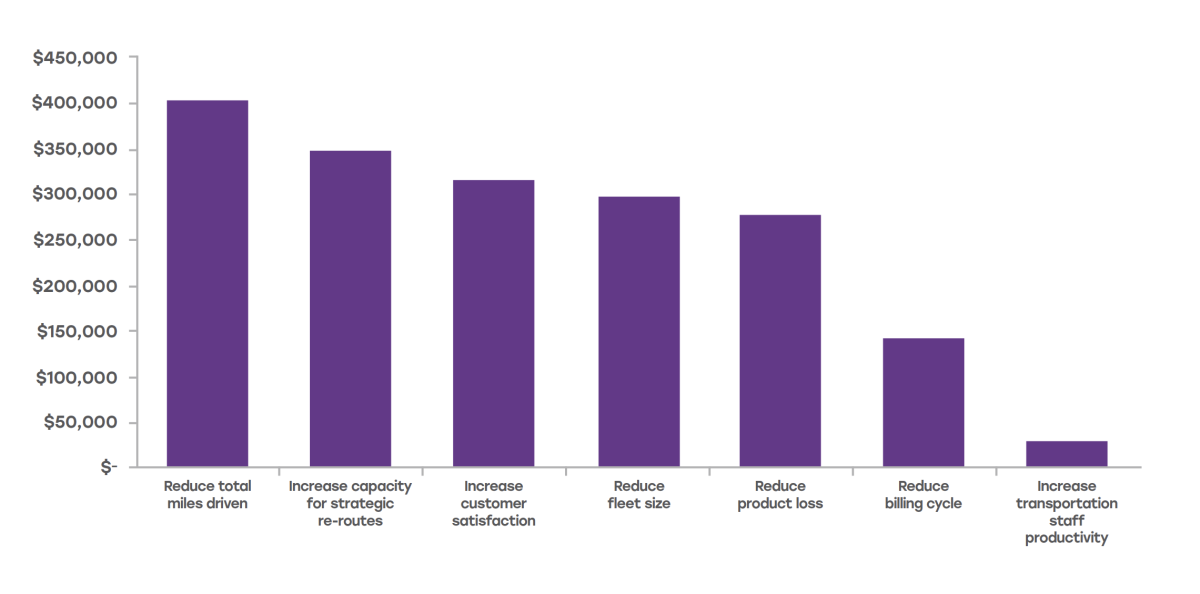
Routing is an ongoing process with changing elements – those responsible for routing change roles, customers move locations or change their order volumes, seasonal and weather changes need to be taken into account and new orders come in as business grows. How fleets manage standard and dynamic routes and the related transportation costs can often be further optimized. While orders may be getting processed and drivers may be making deliveries each day – it may not be getting done in the most efficient way possible by today’s standards. In addition, balancing routes for efficiency and customer service has become crucial for continued success. Customers’ expectations are high given the current environment of instant gratification related to delivery services.
Hobson & Company, a leading research firm focused on Total Cost of Ownership (TCO) and Return on Investment (ROI) studies, worked with Omnitracs Roadnet, a business unit of Omnitracs, LLC, a leader in routing & vehicle tracking software, to explore these challenges and learn how industry leaders are responding. H&C conducted independent research consisting of 12 in-depth interviews with Omnitracs Roadnet clients and found that a validated routing and scheduling solution addressed specific customer challenges across distribution and mobile services companies to deliver a quick and compelling ROI (Return on Investment).
In this blog post, we’ll highlight examples of validated use cases where the impact of Omnitracs Roadnet is not only strategic but also measurable based on key metrics confirmed by current users of the solution.
1. Improved Route Efficiency
Omnitracs Roadnet creates standard and daily routes using powerful algorithms and street-level routing, in conjunction with customer business constraints. This functionality provides an automated method to balance both profitability (including miles driven) and customer requirements. In addition, its GPS-enabled technology enables drivers to more closely follow optimized route plans and uses live tracking to ensure drivers are following the most cost-effective routes, reducing wasted time and mileage.
- Reduce total miles driven by 23%
- Reduce fleet size by 20%
- Reduce labor costs per stop by 5%
- Reduce billing cycle by 15% reduction in Days Sales Outstanding
“By establishing minimum thresholds for standard routes, we were able to reduce routes and eliminate trucks while still being able to make all deliveries.”
— VP Operations & Logistics
2. Improved Staff Productivity
It can be extremely challenging to manage driver productivity as there are so many factors that can impact how efficiently they are able to make deliveries within specific parameters such as individual customer requirements. Omnitracs Routing provides balanced and optimized workloads and helps ensure drivers are on track by providing driver manifests, driver directions, and route maps. In addition, Dispatching allows drivers to stay on task with digital inspection report workflow, item scanning, detailed delivery guides along with any other company assigned tasks prior to marking their departure.
- Reduce driver compensation by 10%
- Reduce driver overtime by 27%
- Reduce time spent routing by 55%
- Reduce time spent on re-routes by 50%
- Reduce time spent on location inquiry calls by 90%
“I am able to spend the time [saved from more efficient routing] on making additional process improvements to our routing and driver management.”
— General Manager
3. Achieve Scalable Growth
With re-routes being extremely time-consuming, many distribution and transportation organizations minimize the number of re-routes done, potentially foregoing opportunities to add customers and/or reduce costs. Omnitracs Roadnet’s Strategic Planner product automates the process of balancing territories and workflows for strategic re-routes which allows them to optimize the capacity of the existing fleet in response to route changes including adding new customers and responding to seasonal or weather related fluctuations.
- Increase revenue by 1% and reduce transportation costs by 0.5%
- Reduce product lost by 75%
- Increase revenue by 1.25%
“By using Dispatching to track inventory through delivery, we’ve reduced product loss by at least 75%.”
— General Manager
In Summary
12 discrete organization-wide benefits were identified during the customer interviews for this research paper. Below is a sample of just a few of those benefits and their potential annual value to an organization with 75 trucks who drives 2 million miles per year at an average operating cost of $0.76 per mile:
The value of a validated vehicle routing, scheduling and fleet management solution is immediate and demonstrable. A sample organization with 75 trucks that drives 2,000,000 miles annually at an average operating cost per mile of $0.76, thatspends 120 hours per month on routing can realize significant financial benefits from an investment in a validated routing solution. For this typical organization, annual benefits can exceed $2.4M per year.
For this sample organization, the three year investment totaling $421K generates a positive return in 3.2 months. The three year net present value (NPV) and return on investment (ROI) are strong at $4.2M and 1,226%, respectively. The key financial metrics for the sample organization were calculated by standard methods with the NPV calculation assuming a 10% cost of capital.
Want to dig into these metrics in more detail? Download the Driving ROI Whitepaper today.
